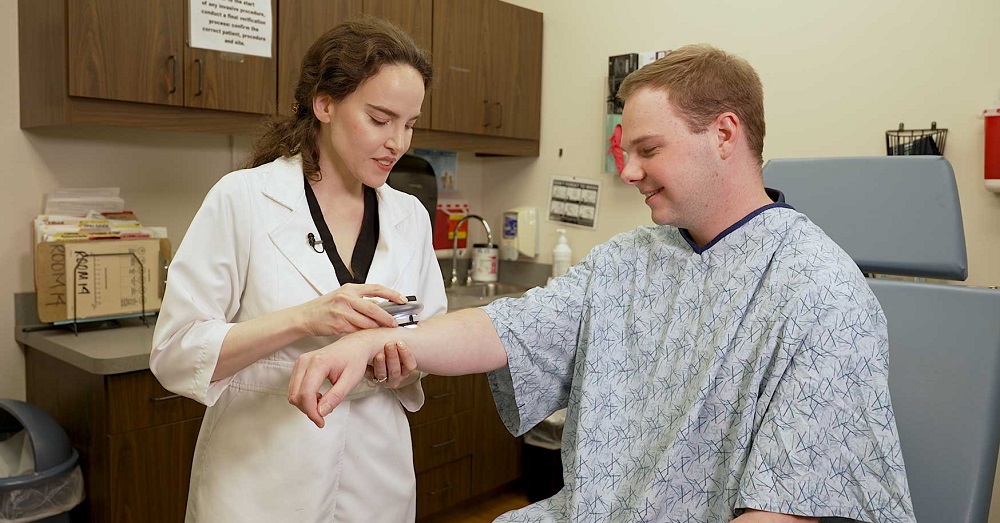TTUHSC Dermatologist Discusses Misconceptions Regarding Skin Cancer

Michelle Tarbox, M.D., addressed some common misconceptions about skin cancer.
Are you protecting yourself from extreme summer sun exposure and other risk factors? Texas Tech University Health Sciences Center dermatologist Michelle Tarbox, M.D., addresses some common misconceptions about skin cancer.
“It can’t happen to me,” Tarbox said. “That’s the most common incorrect skin cancer assumption. The truth is that anybody can get skin cancer. If you have skin, you can get skin cancer on it.”
As reported by The Skin Cancer Foundation, one in five Americans will develop skin cancer by the age of 70.
Tarbox said another misconception is that skin cancer doesn’t happen in the minority community, specifically to people with darker skin. Oftentimes skin cancer can be misdiagnosed as a bruise on someone with darker skin.
“Patients who have the most deeply pigmented skin do have protection against skin cancer and solar radiation,” Tarbox said. “But it isn’t perfect protection and this is something we need to disseminate awareness about. Patients who are African American have a specific category of risk on the palms and the soles called Acral Lentiginous Melanoma. This is a kind of melanoma that can grow on those parts of the body not all of us look at frequently, especially the bottoms of the feet.”
Acral Lentiginous Melanoma infamously took the life of reggae musician Bob Marley. Initially, a lesion on the large toe of his right foot was misconstrued as a bruise. Once the melanoma was discovered, it was too advanced and difficult to treat.
Tarbox said the sun and harmful UV rays are the main factor that contributes to skin cancer.
“It’s really proportionate to the amount of life you lived, how much sun exposure you get, especially with our current sun exposure habits,” Tarbox said. “So really emphasizing good sun protection to all our patients is the strategy that we use to help improve the protection of their skin from the sun, but also to decrease the risk of skin cancer development.”
But Tarbox said another misconception is that people think sun exposure is the only factor that causes skin cancer.
“Other things that contribute to skin cancer are genetics, you can learn about that through family history. Certain kinds of pollutants can potentially increase skin cancer, as can certain medications. So, discuss with your doctor if you’re on any medications that increase the risk of skin cancer.”
There are many recognizable symptoms that come with skin cancer. This includes any skin spot that is bleeding, changing on its own, developing tenderness or itching or has changed colors. Tarbox added that the immune system also plays a role in informing when you have a skin cancer.
“Our immune system pays attention and notices when we have a skin cancer and so we can get redness and itching around the lesion,” Tarbox said. “That doesn’t mean that every itchy spot is skin cancer. But if something has an unusual symptom, bring it to the attention of your physician.”
Skin cancer screenings and self-checks have effectively proven to catch the disease early when it’s most treatable. Tarbox shared her tips on self-checks when it comes to those harder to see places.
When doing self-checks, remember ABCDE, which are the five signs of skin cancer that include asymmetry, border, color, diameter and evolving of the skin spot.
To check the asymmetry, draw a line through the middle of the mole or lesion on your skin. If the two halves are not symmetrical, then the tumor may be malignant. The border of a benign tumor will typically be smooth, while the border of an early melanoma will be jagged or uneven. Melanomas are known for being multiple colors. If a skin spot has multiple colors, bring it to the attention of a physician. Benign moles are typically ¼ inch or smaller in diameter. Melanomas may be larger in diameter and grow quickly.
“A hand mirror can really facilitate a skin exam, as can having a friendly partner to help you out,” Tarbox said. “But I think a really important thing to emphasize is that patients shouldn’t be afraid to examine their own skin. You want to get in all the nooks and crannies and make sure nothing is hiding away that needs to be detected. And just make friends with it. It’s part of your body. It’s part of your life and you want to take the very best care of it because it’s the one garment you wear for your entire life.”
Related Stories
Making Mental Health a Priority in the New Year
Sarah Mallard Wakefield, M.D., a psychiatrist with Texas Tech Physicians, talks about strategies to combat widespread and growing anxiety.
TTUHSC Dean to be Inducted into the National Academies of Practice as Distinguished Fellow
Gerard E. Carrino, Ph.D., MPH, dean of the TTUHSC Julia Jones Matthews School of Population and Public Health, will be inducted into the National Academies of Practice (NAP) as a Distinguished Fellow of the Public Health Academy.
TTUHSC School of Nursing Celebrates 10-Year Anniversary of the Abilene Community Health Center
The TTUHSC School of Nursing hosted a 10-Year Anniversary Celebration and Open House for the Abilene Community Health Center. The center is one of 71 Federally Qualified Health Centers (FQHCs) in Texas according to the Texas Health and Human Services.
Recent Stories
The Ph.D. Programs that Shape Health Care
The Graduate School of Biomedical Sciences Ph.D. programs at TTUHSC provide the foundation, mentorship and research opportunities you need to pursue groundbreaking work.
Finding Your Future: Master’s Programs at the Graduate School of Biomedical Sciences
At the Graduate School of Biomedical Sciences, you will gain hands-on experience, work alongside expert faculty and collaborate in small, supportive classes that help you thrive.
Making Mental Health a Priority in the New Year
Sarah Mallard Wakefield, M.D., a psychiatrist with Texas Tech Physicians, talks about strategies to combat widespread and growing anxiety.
